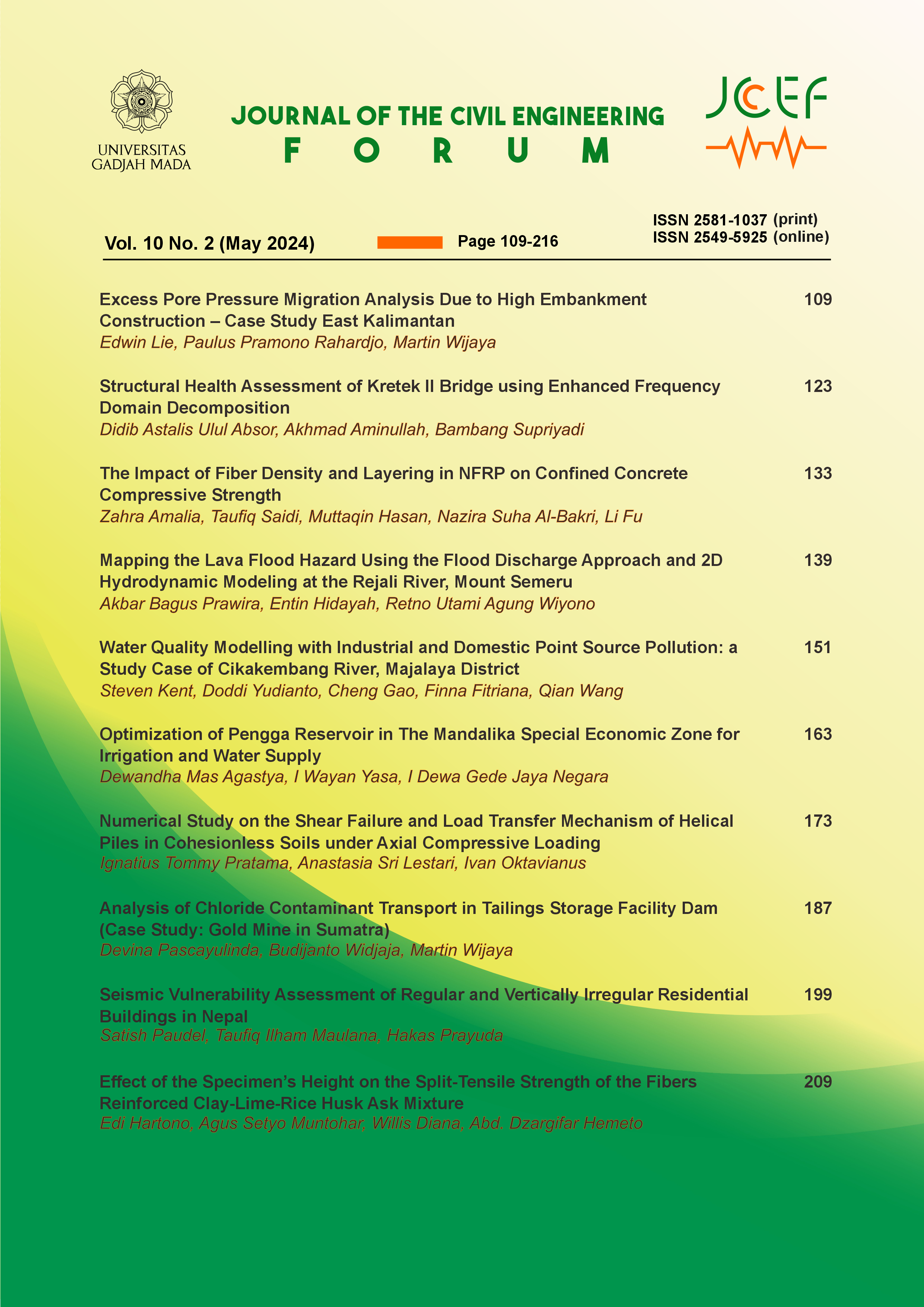Structural Health Assessment of Kretek II Bridge using Enhanced Frequency Domain Decomposition
Abstract
The development of infrastructure is growing rapidly in Indonesia. Kretek II bridge is one of the infrastructures built in the country. Dynamics aspects are one of the very important aspects used to validate structural analysis model or being linked to Structural Health Monitoring (SHM) of the bridge. Dynamics properties such as natural frequency, damping ratio, and mode shape also referred as modal parameters. The objective of this research is to determine the modal parameters of Kretek II bridge using Enhanced Frequency Domain Decomposition (EFDD) which is commonly used to extract modal parameters from the acceleration data recorded. Compared to the conventional method, EFDD is very practical and robust in structural health assessment because of its user-friendly uses in the ARTeMIS Modal software. To make sure that the results from EFDD are accurate, numerical modeling is necessary to validate it. This research was conducted using dynamics load test results as data for the modal extraction with EFDD method assisted by ARTeMIS Modal software. Dynamics load test was performed by placing 8 accelerometers in the span and exciting it with impact load from dropped truck on ramp. Modal parameters from the EFDD results are then compared to the numerical modeling results. The first two modes of the EFDD and numerical modeling results consecutively are 3.09 Hz, 3.745 Hz and 3.06 Hz, 3.49 Hz. The EFDD and numerical modeling results are both in agreement with both results having similar mode shape on their first two mode and low error percentage with only 0.89% and 7.17% respectively.
References
Brincker, R. and Ventura, C. E. (2015), Introduction to Operational Modal Analysis, Wiley.
Brincker, R., Ventura, C. E. and Andersen, P. (2001), Damping estimation by frequency domain decomposition, in ‘Proceedings of IMAC 19: A Conference on Structural Dynamics’, Hyatt Orlando, Kissimmee, Florida, pp. 698–703.
Brincker, R. and Zhang, L. (2009), Frequency domain decomposition revisited, in ‘Proceedings of the 3rd International Operational Modal Analysis Conference - IOMAC’, p. 615.
Brincker, R., Zhang, L. and Andersen, P. (2000a), Modal identification from ambient responses using frequency domain decomposition, in ‘Proceedings of the International Modal Analysis Conference (IMAC)’, Vol. 18, San Antonio, Texas, USA, pp. 625–630.
Brincker, R., Zhang, L. and Andersen, P. (2000b), Modal identification of output-only systems using frequency domain decomposition, in ‘Proceedings of the European COST F3 Conference on System Identification & Structural Health Monitoring’, Universidad Politécnica de Madrid, Spain, pp. 273–282.
Brincker, R., Zhang, L. and Andersen, P. (2000c), Output-only modal analysis by frequency domain decomposition, in ‘Proceedings of ISMA25: 2000 International Conference on Noise and Vibration Engineering’, Katholieke Universiteit, Leuven, pp. 717–723.
El-Borgi, S., Smaoui, H., Cherif, F., Bahlous, S. and Ghrairi, A. (2004), ‘Modal identification and finite element model updating of a reinforced concrete bridge’, Emirates Journal for Engineering Research 9.
Ghalishooyan, M., Shooshtari, A. and Abdelghani, M. (2019), ‘Output-only modal identification by inoperation modal appropriation for use with enhanced frequency domain decomposition method’, Journal of Mechanical Science and Technology 33, 3055–3067. URL: https://doi.org/10.1007/s12206-018-0906-1
Ma, J. and Luan, W. (2020), Modal identification of a building structure by frequency domain decomposition, in ‘IOP Conference Series: Materials Science and Engineering’, Vol. 794, Institute of Physics Publishing. URL: https://doi.org/10.1088/1757-899X/794/1/012048
Mao, Q., Mazzotti, M., DeVitis, J., Braley, J., Young, C., Sjoblom, K., Aktan, E., Moon, F. and Bartoli, I. (2019), ‘Structural condition assessment of a bridge pier: A case study using experimental modal analysis and finite element model updating’, Structural Control and Health
Monitoring 26. URL: https://doi.org/10.1002/stc.2273
Morris, A. S. and Langari, R. (2012), Measurement and Instrumentation Theory and Application, Vol. 7 of SyriaStudies.
Orlowitz, E. and Brandt, A. (2017), ‘Comparison of experimental and operational modal analysis on a laboratory test plate’, Measurement: Journal of the International Measurement Confederation 102, 121–130. URL: https://doi.org/10.1016/j.measurement.2017.02.001
Pastor, M., Binda, M. and Harčarik, T. (2012), Modal assurance criterion, in ‘Procedia Engineering’, Vol. 48, Elsevier Ltd, pp. 543–548. URL: https://doi.org/10.1016/j.proeng.2012.09.551
Salawu, O. S. (1997), ‘Detection through changes a review’, Engineering Structures 19, 718–723.
Schwarz, B. J. and Richardson, M. H. (1999), ‘Experimental modal analysis’.
Sevim, B., Bayraktar, A., Altunişik, A. C., Adanur, S. and Akköse, M. (2010),‘Modal parameter identification of a prototype arch dam using enhanced frequency domain decomposition and stochastic subspace identification techniques’.
Copyright (c) 2024 The Author(s)

This work is licensed under a Creative Commons Attribution-ShareAlike 4.0 International License.
Copyright is granted to authors for the purpose of providing protection for articles written to describe experiments and their results. JCEF will protect and defend the work and reputation of the author and are also willing to address any allegations of violation, plagiarism, fraud, etc. against articles written and published by JCEF. JCEF is published under the terms of the Creative Commons Attribution-ShareAlike 4.0 International License (CC BY-SA 4.0). The author holds the copyright and assigns the journal rights to the first publication (online and print) of the work simultaneously.







